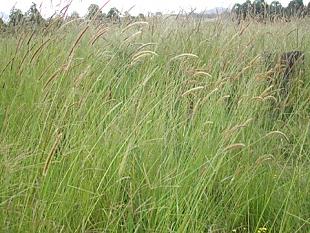
Setaria
NOTE: The information in this Agnote must be read in conjunction with Agnote DPI-263 Introduction to selecting and using pastures in NSW, which covers information on areas of adaptation, sources of variability, species mixtures, and important issues related to animal health and the conservation of native vegetation.
Pasture type and use

Summer-growing perennial grass for grazing and hay.
Area of adaptation
Moist subtropics of the North Coast and Manning.
Min. average annual rainfall
1000 mm
Advantages
- Wide adaptability to topography and soil types.
- High dry-matter production early spring, summer and autumn.
- Tolerates occasional shallow flooding and wet soil conditions.
- Reduces fireweed to low frequencies.
- Fertilised with nitrogen, can rapidly accumulate dry matter for hay production or grazing.
- Although little growth occurs in winter, green leaf carries well into winter.
Disadvantages
- High oxalate levels make setaria unsuitable for horses and donkeys.
- With regrowth beyond 40 cm, quality drops markedly.
Soil requirements
Versatile, from sandy to clay soils. Does best on deep soils with good moisture-holding ability. Although persisting under low soil fertility, setaria requires medium to high fertility for productive growth.
Varieties
Select varieties on the basis of frost tolerance, and local production and persistence data (where available).
- Frost-susceptible: Kazungula, Splenda P
Note: 'P' denotes that this variety is protected by Plant Breeder's Rights. - Frost-tolerant: Narok, Solander
Sowing rates:
- as only species: 1.5–2.5 kg/ha for irrigated nitrogen-fertilised grass.
- in mixtures: 1.5–2.5 kg/ha with legumes. Rarely sown with other grasses. 1.0 kg/ha with greater lotus cv Maku.
Sowing time
From spring to early autumn. Must suit legume. For Far North Coast, February best month. Surface sow onto prepared seedbed and roll.
Companion species
In warm hill sites, often sown with twining tropical legumes. If kept short can be grown with white clover.
At lower butt densities and adequate interstitial areas, greater lotus can be grown successfully with setaria. Oversowing greater lotus seed into established setaria pasture is mostly unsuccessful.
Inoculation
N/A
Major nutrient deficiencies
Nitrogen, phosphorus, potassium and sulfur.
Main insect pests
Army worms and pasture web worms. Buffel grass seed caterpillar damages seed heads from late January.
Main diseases
Pyricularia leaf spot.
Management
Tall, rank setaria pastures without twining tropical legumes are undesirable and usually require slashing. Manage to maintain persistence and productivity of the companion legume. Maintain a short open sward for white clover and greater lotus. Sod-bound swards require renovation to provide space for white clover.
Livestock disorders of particular note
Frequently hyperparathyroidism (‘big head’) in horses, occasionally nephrosis or hypocalcaemia in ruminants, due to oxalates.
Further information
Agnote DPI-224 Setaria for coastal pastures
Acknowledgments
Advice on livestock health disorders was provided by Dr Chris Bourke, Principal Research Scientist, NSW Agriculture, Orange. His contribution is gratefully acknowledged.
Photo: Bede Clarke, NSW Agriculture, Casino

